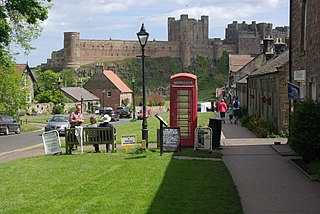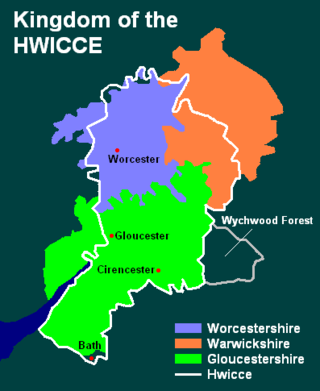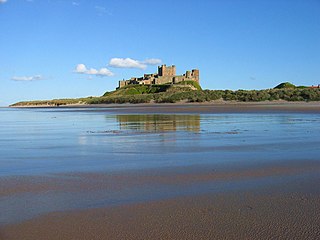Ealdred may refer to:

Ealdred was Abbot of Tavistock, Bishop of Worcester, and Archbishop of York in early medieval England. He was related to a number of other ecclesiastics of the period. After becoming a monk at the monastery at Winchester, he was appointed Abbot of Tavistock Abbey in around 1027. In 1046 he was named to the Bishopric of Worcester. Ealdred, besides his episcopal duties, served Edward the Confessor, the King of England, as a diplomat and as a military leader. He worked to bring one of the king's relatives, Edward the Exile, back to England from Hungary to secure an heir for the childless king.
Year 1038 (MXXXVIII) was a common year starting on Sunday of the Julian calendar.

Bamburgh is a village and civil parish on the coast of Northumberland, England. It had a population of 454 in 2001, decreasing to 414 at the 2011 census.

Hwicce was a kingdom in Anglo-Saxon England. According to the Anglo-Saxon Chronicle, the kingdom was established in 577, after the Battle of Deorham. After 628, the kingdom became a client or sub-kingdom of Mercia as a result of the Battle of Cirencester.
Æthelberht, Aethelbert or Ethelbert is a masculine given name which may refer to:

Ealdorman was a term in Anglo-Saxon England which originally applied to a man of high status, including some of royal birth, whose authority was independent of the king. It evolved in meaning and, in the eighth century, was sometimes applied to the former kings of territories which had submitted to great powers, such as Mercia. In Wessex in the second half of the ninth century, it meant the leaders of individual shires appointed by the king. By the tenth century, ealdormen had become the local representatives of the West Saxon king of England. Ealdormen would lead in battle, preside over courts, and levy taxation. Ealdormanries were the most prestigious royal appointments, the possession of noble families, and semi-independent rulers. Their territories became large, often covering former kingdoms, such as Mercia or East Anglia. Southern ealdormen often attended court, reflecting increasing centralisation of the kingdom, but the loyalty of northern ealdormen was more uncertain. In the eleventh century, the term eorl, today's earl, replaced that of ealdorman, but this reflected a change in terminology under Danish influence rather than a change in function.
Uhtred is a masculine given name of Anglo-Saxon origin, prevalent during the Medieval period. It may refer to:
Ealdred was styled as Dux (Duke) by Offa of the Anglo-Saxon kingdom of Hwicce but considered himself as King, jointly ruling with his brothers Eanberht and Uhtred in the later half of the 8th century AD.
Eadwulf or Eadulf was ruler of Bamburgh in the early tenth century. A genealogy in the twelfth-century text De Northumbria post Britannos recording the ancestry of Waltheof Earl of Northampton, makes Eadwulf the son of Æthelthryth daughter of Ælla, King of Northumbria, but no source names Eadwulf's own father.
Ealdred was a ruler of Bamburgh, at least part of the former kingdom of Bernicia in northern Northumbria, in the early tenth century. He was the son of Eadwulf.
Uhtred of Bamburgh, was ruler of Bamburgh and from 1006 to 1016 the ealdorman of Northumbria. He was the son of Waltheof I, ruler of Bamburgh (Bebbanburg), whose family the Eadwulfings had ruled the surrounding region for over a century. Uhtred's death by assassination was described in De obsessione Dunelmi and has been interpreted as the beginning of a blood feud. Not to be confused with Uhtred the son of Eadwulf I of Bamburgh, which is why he historically has been referred to as Uhtred the Bold.

Oswulf was ruler of Bamburgh and subsequently, according to later tradition, commander of all Northumbria under the lordship of King Eadred of England. He is sometimes called "earl" or "high reeve", though the precise title of the rulers of Bamburgh is unclear. By the twelfth century Oswulf was held responsible for the death of Northumbria's last Norse king, Eric of York, subsequently administering the Kingdom of York on behalf of Eadred.
Waltheof was high-reeve or ealdorman of Bamburgh. He was the son of Ealdred, and the grandson of Oswulf I and was father of Uhtred the Bold, Ealdorman of Northumbria. His name is Scandinavian which may imply that he had Viking ancestors.

The Battle of Carham was fought between the English ruler of Bamburgh and the king of Scotland in alliance with the Cumbrians. The encounter took place in the 1010s, most likely 1018, at Carham on Tweed in what is now Northumberland, England. Uhtred, son of Waltheof of Bamburgh, fought the combined forces of Malcolm II of Scotland and Owen the Bald, king of the Cumbrians. The result of the battle was a victory for the Scots and Cumbrians.
Eadwulf III of Bamburgh or Eadwulf Cudel or Cutel was ruler of Bamburgh for some period in the early eleventh century. Following the successful takeover of York by the Vikings in 866/7, southern Northumbria became part of the Danelaw, but in the north English rulers held on from a base at Bamburgh. They were variously described as kings, earls, princes or high-reeves, and their independence from the kings of England and Scotland is uncertain. Uhtred the Bold and Eadwulf Cudel were sons of Waltheof, ruler of Bamburgh, who died in 1006. He was succeeded by Uhtred, who was appointed by Æthelred the Unready as earl in York, with responsibility for the whole of Northumbria. Uhtred was murdered in 1016, and king Cnut then appointed Erik, son of Hakon, earl at York, while Eadwulf succeeded at Bamburgh.
Ealdred was an Earl in north-east England from the death of his uncle, Eadwulf Cudel, soon after 1018 until his murder in 1038. He is variously described by historians as Earl of Northumbria, Earl of Bernicia and Earl of Bamburgh, his stronghold on the Northumbrian coast. He was the son of Uhtred, Earl of Northumbria, who was murdered by Thurbrand the Hold in 1016 with the connivance of Cnut. Ealdred's mother was Ecgfrida, daughter of Aldhun, bishop of Durham.
Aldred is both a given name and a surname. Notable people with the name include:
De obsessione Dunelmi is an historical work written in the north of England during the Anglo-Norman period, almost certainly at Durham, and probably in either the late 11th or early 12th century.
Eadwulf II, nicknamed Evil-child, was ruler of Bamburgh in the latter half of the tenth century. Although Eadwulf is sometimes described as the Earl of Northumbria, he ruled only a northern portion of Northumbria, a polity centred on Bamburgh that once stretched from the Firth of Forth to the River Tees.